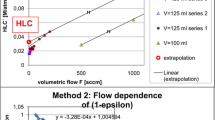Abstract
The use of membrane-inlet mass spectrometry in the study of dissolved gas concentrations in the rumen was evaluated in order to assess the value of the technique as a tool for the study of microbial activity in ecosystems in situ. Four dissolved gases (CH4, CO2, H2, and O2) were measured simultaneously and continuously for short periods (up to 30 min) during the feeding period. These preliminary results have demonstrated the usefulness of the technique for monitoring microbial activity via gas production in a complex natural ecosystem.
Similar content being viewed by others
Literature Cited
Bird SH, Leng RA (1983) The influence of the absence of rumen protozoa on ruminant production. In: Farrell DJ, Vohra P (eds) Recent advances in animal nutrition in Australia. Armidale: University of New England Press, pp 110–118
Bohátka S, Langer G, Szilagyi J, Berecz I (1983) Gas concentration determination in fermentors with quadrupole mass spectrometer. Int J Mass Spectrometry Ion Phys 48:277–280
Coleman GS (1978) Rumen entodiniomorphid protozoa. In: Taylor AER, Baker JR (eds) Methods of cultivation of parasites in vitro. London: Academic Press, pp 39–54
Coleman GS (1979) Rumen ciliate protozoa. In: Levandowsky M, Hunter SH (eds) Biochemistry and physiology of protozoa. London: Academic Press, pp 381–408
Coleman GS (1980) Rumen ciliate protozoa. In: Lumsden WHR, Muller R, Baker JR (eds) Advances in parasitology, vol 18. London: Academic Press, pp 121–173
Czerkawski JW, Breckenridge G (1971) determination of concentration of hydrogen and some other gases dissolved in biological fluids. Lab Pract 20:403–405 and 413
Czerkawski JW, Clapperton JL (1968) Analysis of gases produced by metabolism of microorganisms. Lab Pract 17:994–996
Eadie JM, Gill JC (1971) The effect of the absence of rumen ciliate protozoa on growing lambs fed a roughage-concentrate diet. Br J Nutr 26:155–167
Hillman K, Lloyd D, Williams DG (1985) Continuous monitoring of fermentation gases in an artificial rumen system (RUSITEC) using a membrane-inlet probe on a portable quadrupole mass spectrometer. In: Degn H, Cox RP, Toftlund H (eds) Gas enzymology. Dordrecht, The Netherlands: D Reidel, pp 201–206
Jouany JP, Senaud J (1979) Defaunation de rumen de mouton. Ann Biol Anim Biochim Biophys 19:619–624
Lloyd D, Williams J, Yarlett N, Williams AG (1982) Oxygen affinities of the hydrogenosome-containing protozoaTritrichomonas foetus andDasytricha ruminantium, and two aerobic protozoa, determined by bacterial bioluminescence. J Gen Microbiol 128:1019–1022
Lloyd D, Scott RI, Williams TN (1983) Membrane-inlet mass spectrometry: measurement of dissolved gases in fermentation liquids. Trends Biotechnol 1:60–63
Lloyd D, Bohátka S, Szilagyi J (1985) Quadrupole mass spectrometry in the monitoring and control of fermentations. Biosensors 1 (in press)
McArthur JM, Miltimore JE (1961) Rumen gas analysis by gas-solid chromatography. Can J Anim Sci 41: 187–196
Muller M (1980) The hydrogenosome. In: Gooday GW, Lloyd D, Trinci APJ (eds) The eukaryotic microbial cell. Society for General Microbiology Symposium, vol 30. Cambridge: Cambridge University Press, pp 127–141
Scott RI, Yarlett N, Hillman K, Williams TN, Williams AG, Lloyd D (1983) The presence of oxygen in rumen liquor and its effects on methanogenesis. J Appl Bacteriol 55:143–149
Whitelaw FG, Eadie JM, Bruce LA, Shand WJ (1984) Methane formation in faunated and ciliate-free cattle and its relationship with rumen volatile fatty acid proportion. Br J Nutr 52:261–275
Yarlett N, Hann Ao C, Lloyd D, Williams AG (1981) Hydrogenosomes in the rumen protozoonDasytricha ruminantium Schuberg. Biochem J 200:365–372
Yarlett N, Hann Ao C, Lloyd D, Williams AG (1983) Hydrogenosomes in a mixed isolate ofIsotricha prostoma andIsotricha intestinalis from ovine rumen contents. Comp Biochem Physiol 74B:357–364
Yarlett N, Coleman GS, Williams AG, Lloyd D (1984) Hydrogenosomes in known species of rumen entodiniomorphid protozoa. FEMS Microbiol Lett 21:15–19
Author information
Authors and Affiliations
Rights and permissions
About this article
Cite this article
Hillman, K., Lloyd, D. & Williams, A.G. Use of a portable quadrupole mass spectrometer for the measurement of dissolved gas concentrations in ovine rumen liquor in situ. Current Microbiology 12, 335–339 (1985). https://doi.org/10.1007/BF01567893
Issue Date:
DOI: https://doi.org/10.1007/BF01567893




